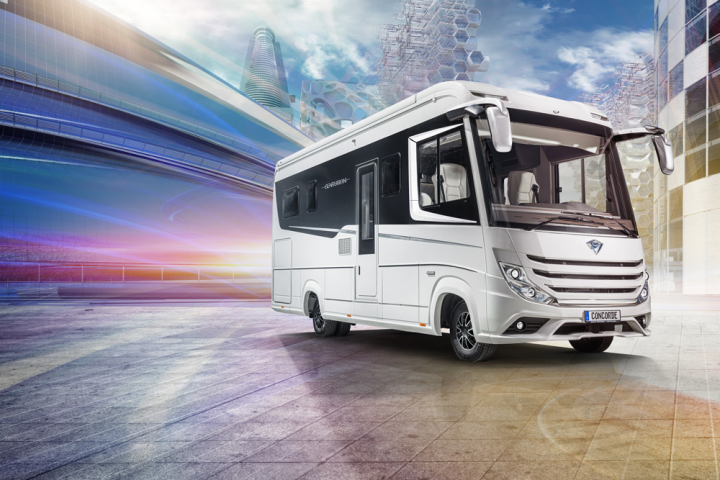"Without polymers, we would not be able to have such a successful design"

Your motorhomes are rather luxurious. Who are they for?
They are designed for those who do not want to give up the comfort and convenience of home when travelling. They are true homes on wheels where nothing is overlooked. Our equipment and technology are present so that our customers can enjoy the freedom that our vehicles provide.

|
Polymers are very present in the motorhomes. Why use these materials?
Using polymers in motorhomes is and will remain essential. The bodywork elements, for example, require very large parts that we want to shape to meet the requirements of design and size. In addition, as with all vehicles, weight is also a constraint that plastics help us to overcome due to their low mass. If only to overcome this double constraint, polymers are indispensable and eliminate most other materials from the running. We mainly use fibreglass/epoxy composites, especially for the front and rear body sections and the side walls.

|
In the case of motorhomes, they are of course insulated. We use expanded polystyrene foam (XPS) sandwiched in the body sections. |
One of the most luxurious models in your range, the Centurion, features polymers. Which ones did you choose?The incredible plasticity of polymers allows for a lot of boldness, especially in terms of design. Without them, it would have been impossible to achieve the concave and convex curves that give a real personality to our vehicles and more particularly to the Centurion, our prestige model. |

|
On the outside, the rear end is unique with a floating spoiler that can hide a door. The side walls and front end are also the result of elaborate design work.
In the living areas of the interior, we have tried to banish all sharp angles and replace them with more aesthetic curves. The structure of our furniture is composed of a polyethylene core inserted between two thin sheets of plywood. This composite, which is very strong and much lighter than raw wood, is coated with polymers such as ABS or melamine resin. This is purely aesthetic and reinforces our high-end image. Using these materials also reduces our volatile organic compounds, since by applying them to our furniture we emit fewer VOCs than by painting or varnishing it.

|
As for our dashboards, they look like a modern cockpit with smooth lines and ergonomic design *. Again, this is achieved by using plastics.

|
* Dashboards today are a concentrate of polymers: polypropylene (PP), acrylonitrile butadiene styrene (ABS), polyvinyl chloride (PVC), etc. They are foamed, brushed and take on the 'craziest' shapes to adapt to the aesthetic demands of drivers. Manufacturers very rarely reveal the exact nature of the polymers that make them up.
What are your ties with polymer manufacturers?
We work with many suppliers and can therefore draw on different polymer catalogues for greater flexibility. Polymer manufacturers are very attentive to our needs and it is not unusual for us to work together to find solutions to improve existing polymers.
What are the main constraints you encounter? Do polymers help you solve them?
The main challenges are mostly related to the products we mould from thermosetting polymers. The main difficulty is related to their non-standard dimensions. Managing the curing time and therefore the hardening with precision is essential to ensure that the part can be removed from the mould without any risk of damage. In the same vein, the parts must be able to be transported without twisting even a few millimetres.

|
These technical considerations are essential to ensure that these parts fit exactly as they should. |
This allows us to see immediately whether the polymer cure was optimal and thus, whether the part is perfect.
What changes will the electrification of vehicles bring to your business?What changes will the electrification of vehicles bring to your business?
It is a challenge that we will be taking up in the coming years! Some of our models have a garage for a small car. We are currently studying the possibility of using the large electricity storage units in our vehicles to recharge an electric vehicle stored in the garage.
|
The electrification of our motor homes is still very complicated: their autonomy is quite short and there are still few charging points in the places favoured by our customers, such as the countryside, the mountains, etc. |

|
But things are changing very quickly and we are closely following technological developments to quickly meet all expectations: ours, those of our customers and future legislation.
Do you have other projects to make your vehicles greener?
These are more than just projects, as some solutions have already been implemented. Environmental protection is an issue that we, like our customers, understand is very important. Most of our vehicles are already configured to be self-sufficient in the long term, for example by using polymer solar panels or lithium batteries.
In a few words, what is the history of your company?
Concorde was founded in 1981 and initially produced folding caravans and custom-made trailers, some of which could be transformed into exhibition stands.
In 1983, the foundation stone of the success story was laid with the production of the first sixty motorhomes named Concorde.
In 1994, double-floor alcoves were presented to the public for the first time.
Some innovations have left their mark on the minds of campers, such as in 2005 when we launched the Charisma. It was the first vehicle to have the driver's cabin seats swivel backwards (towards the lounge), creating a living space never before seen in a motorhome. The Centurion was introduced in January 2013. Since then, it has of course evolved and is still considered a benchmark in the field.

|





